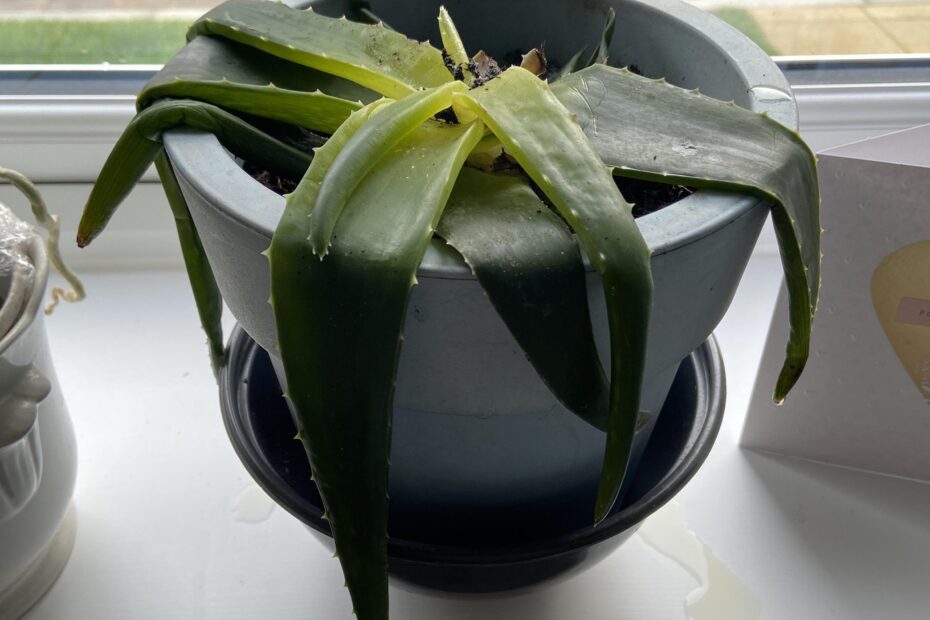The Great Arctic Aloe Expedition: Unveiling the Truth Behind Frozen Aloe Vera Plant Survival
In the icy realms of Arctic eccentricity, the world of botanical wonders, a chilling question has gripped the minds of plant enthusiasts and gardeners alike—can an aloe vera plant, encased in an icy slumber, escape the clutches of frosty demise? Brace yourselves as we embark on a frozen quest, emboldened by curiosity, to untangle the enigma surrounding our prickly green friend. Will this daring expedition reveal the secret formula for defying Mother Nature’s icy wrath, or will it leave us with frostbitten hopes? Join us as we dive headfirst into an exploration beyond imagination, where frosted leaves meet scientific intrigue and the survival of aloe vera hangs precariously in the balance. For those thirsting for answers, the truth lies just beneath the frosty surface.
Understanding the Impact of Freezing on Aloe Vera Plants
If you’ve ever owned an Aloe Vera plant, you know how hardy and resilient they can be. However, even these amazing plants have their limits. In this post, we will delve into the impact freezing temperatures can have on Aloe Vera plants and whether or not they can be saved.
When exposed to freezing temperatures, Aloe Vera plants are at risk of experiencing significant damage. The plant’s cells can freeze, leading to irreversible damage that can cause the leaves to turn mushy and translucent. This can be a heart-wrenching sight for any plant enthusiast. However, all hope is not lost! If your Aloe Vera plant has been exposed to freezing temperatures, there are steps you can take to potentially save it and nurse it back to health.
To aid in understanding how freezing impacts Aloe Vera plants, here are some key features and tips to keep in mind:
| Features/Tips | Description |
|---|---|
| Insulate the plant | Cover the entire plant with a frost cloth or blanket to provide some protection against freezing temperatures. |
| Move indoors | When the forecast calls for freezing temperatures, consider bringing your Aloe Vera plant indoors, where the temperature can be controlled and kept above freezing. |
| Assess damage | Once the temperature rises and the danger of freezing has passed, examine your Aloe Vera plant for any signs of damage. Carefully trim off any mushy or translucent leaves, allowing the plant to redirect its energy towards new growth. |

Insightful Tips to Save Your Frozen Aloe Vera Plant
So your beloved aloe vera plant got exposed to freezing temperatures, and now you’re left wondering if it can be saved. Don’t fret just yet! While aloe vera plants are generally hardy, extreme cold can cause irreparable damage. However, with the right care and a little bit of luck, there’s a good chance you can revive your frozen aloe vera back to its vibrant self.
Here are some insightful tips to help your frozen aloe vera plant bounce back:
| Feature/Tips | Description |
|---|---|
| Slow Thawing | Gradually introduce your frozen aloe vera plant to warmer temperatures over a few days to prevent shock and further damage. |
| Indoor Relocation | If possible, bring your frozen aloe vera plant indoors to a warmer environment where it can recuperate from the freezing exposure. |
| Provide Adequate Lighting | Place your aloe vera in a well-lit area, preferably near a sunny window, to encourage healthy growth and recovery. |
Remember, every aloe vera plant is different, and the extent of the damage will vary. Patience and careful attention to its needs will be key during the recovery process. By following these tips, you give your frozen aloe vera the best chance to spring back to life and thrive once again!

Proven Methods to Revive a Frozen Aloe Vera Plant
When your beloved aloe vera plant gets exposed to freezing temperatures, it can be disheartening. However, there is hope for its recovery! Here are some and save it from wilting away:
1. Gradual Thawing:
Carefully bring your frozen aloe vera plant indoors and place it in a spot with indirect sunlight. Let it gradually thaw at room temperature. Avoid applying any heat source directly to the plant, as it can further damage its delicate tissues.
2. Trimming Damaged Leaves:
Inspect your aloe vera plant for frost-damaged leaves. Using clean and sharp scissors, trim off the brown and mushy parts of the leaves. This will encourage new growth and prevent the plant from wasting energy on irreparable tissues.
| Features/Tips | Description |
|---|---|
| Provide Adequate Drainage | Ensure your aloe vera plant is in a pot with drainage holes to prevent waterlogging, which can exacerbate its recovery. |
| Optimal Watering | Water your aloe vera sparingly, allowing the soil to dry thoroughly between each watering session to prevent root rot. |
| Patience is Key | Reviving a frozen aloe vera plant takes time and patience. Monitor its progress, provide the right conditions, and let nature work its magic. |
3. Protection from Future Freezing:
To avoid further freezing episodes, ensure you place your aloe vera plant in a location free from drafts and cold air. If needed, consider moving it indoors during colder periods or provide protective coverings when exposed to frost.
By following these methods and providing the right care, your frozen aloe vera plant has a good chance of making a full recovery. Stay optimistic and offer it the care it needs, and you may soon see its vibrant green leaves thriving once again!

Expert Recommendations to Prevent Further Damage to Frozen Aloe Vera Plants
Are you wondering if your frozen aloe vera plant can be saved? Fear not! Our team of experts is here to provide you with some valuable recommendations to help your beloved aloe vera plant bounce back from the freezing temperatures. While icy conditions can be detrimental to these resilient plants, with proper care and attention, you can increase the chances of reviving your frozen aloe vera plant.
| Features/Tips | Description |
|---|---|
| Protective Covering | Apply a layer of burlap or an insulating fabric to shield the plant from harsh winds and frost. This covering acts as a protective barrier, trapping heat and preventing further damage. |
| Gradual Thawing | Avoid the temptation to thaw your frozen aloe vera plant abruptly. Gradual thawing is crucial as sudden temperature changes can shock the plant’s cells. Bring it indoors to a cool location and allow it to defrost slowly over time. |
| Optimal Drainage | Ensure proper drainage for your aloe vera plant to prevent waterlogging. Excess moisture can cause root rot, further adding stress to the already damaged plant. Adjust watering frequency accordingly and keep an eye on the soil’s moisture level. |
Remember to abstain from trimming any frost-damaged leaves immediately. It’s essential to allow the plant to recover and determine which parts can rejuvenate. Be patient and monitor the plant closely, providing ample sunlight and gentle care. With time and adherence to these expert recommendations, there’s a good chance your frozen aloe vera plant will spring back to life, flourishing once again in all its natural splendor!
Frequently Asked Questions
Q: Can a frozen aloe vera plant be brought back to life?
A: From the frosty depths of a chilly winter, emerges the question: Can frozen aloe vera find its way back to vitality? The answer, my friend, lies not only in the hands of Mother Nature but also in your tender care. With a touch of patience and a dash of nurturing, there’s hope for the frozen aloe vera to thaw and thrive once more!
Q: What should I do if my precious aloe vera plant freezes?
A: Fear not, brave plant parent! When you discover your cherished aloe vera succumbing to the frigid embrace of Jack Frost, act swiftly and decisively. First and foremost, relocate the plant to a warmer, sheltered spot away from frost’s icy fingers. Allow it to gradually thaw in the safety of indoor warmth. Soon, you may witness signs of life sprouting from its frozen facade!
Q: How can I revive a partially frozen aloe vera plant?
A: Reviving a partially frozen aloe vera requires a gentle touch and a loving heart. Begin by pruning any visibly damaged or blackened parts, ensuring to use clean tools. Allow the plant to dry out completely before watering it sparingly. As spring breathes life into the world, gradually introduce your aloe vera to more light and adjust watering accordingly. With patience and tender care, your resilient aloe vera may yet rebound from its icy slumber! In conclusion, the mysterious journey of the frozen aloe vera plant comes to an end. While the frozen state may initially alarm us, it is comforting to know that all hope is not lost for these resilient succulents. As they lay frozen in time, their ultimate fate rests solely in our hands. Will we take the chance and embark on a daring rescue mission? Or will they remain forever encapsulated in their icy prison?
The answer lies within our determination and knowledge. Armed with the proper techniques, these frozen beauties stand a fighting chance. By gently thawing their frozen leaves and ensuring a warm and conducive environment, we can witness the miracle of their revival. Nature, with all its wonders, never ceases to surprise us.
Yet, let us not forget the wisdom gained from this frozen ordeal. It serves as a reminder that prevention is key. By protecting our beloved aloe vera plants from extreme temperatures, we can spare them this chilling fate. But should we find ourselves faced with a frozen aloe vera plant, fear not dear readers, for all is not lost.
In the grand tapestry of life, every setback is an opportunity for growth and discovery. The frozen aloe vera plant serves as a shining example of this. From the depths of icy despair, they may emerge stronger and more tenacious than ever before.
So, let us continue on this journey of horticultural triumphs and tribulations, always seeking knowledge and finding solace in the resilience of nature. May our frozen aloe vera plants be thawed, their vibrant green leaves returning to bask in the warmth of the sun, reminding us that with a little care and patience, miracles can indeed bloom even in the most frozen of circumstances.
- When to Put Weed and Feed on Lawn in Michigan - October 16, 2023
- When to Fertilize Potatoes Plants - October 16, 2023
- Can You Plant Clover in the Spring - October 16, 2023

